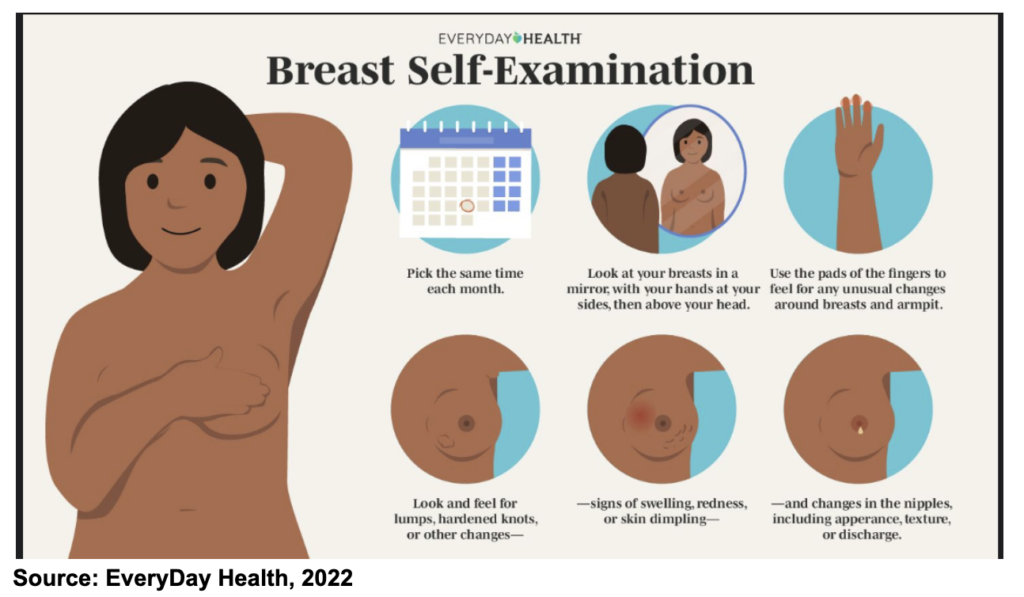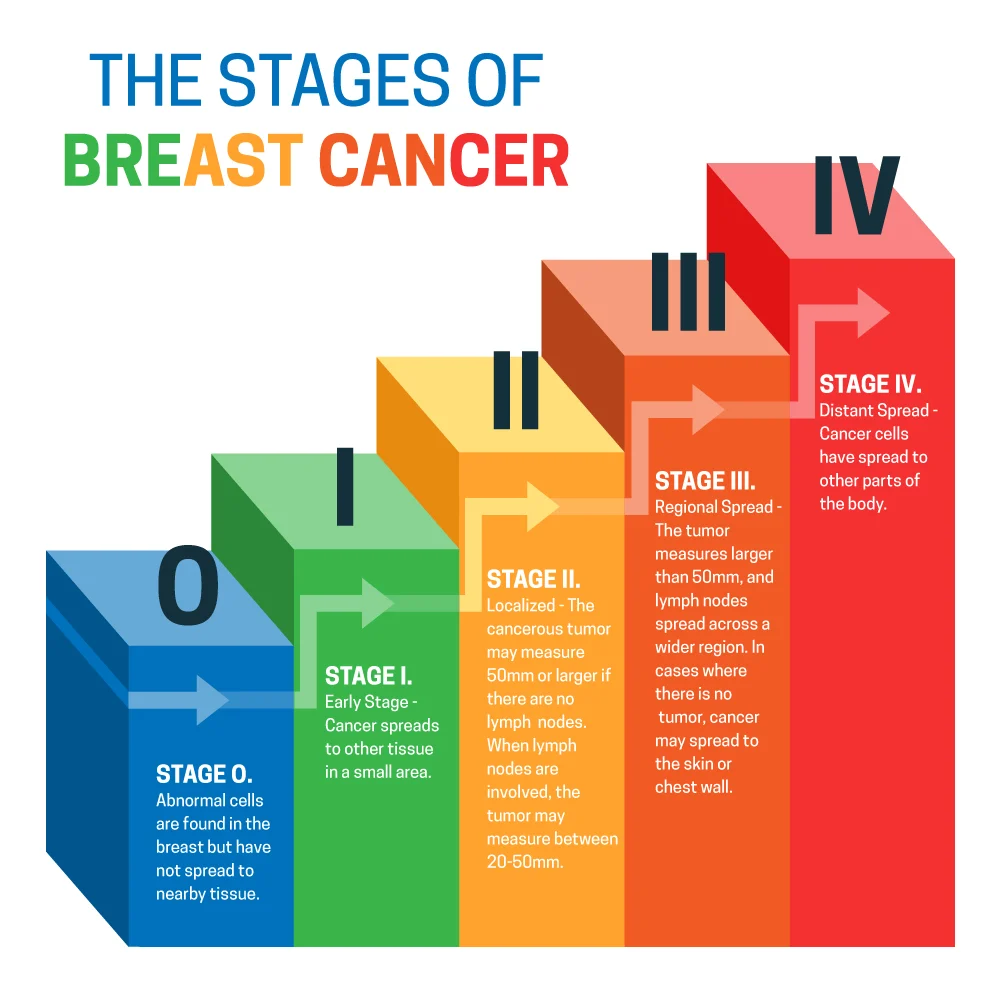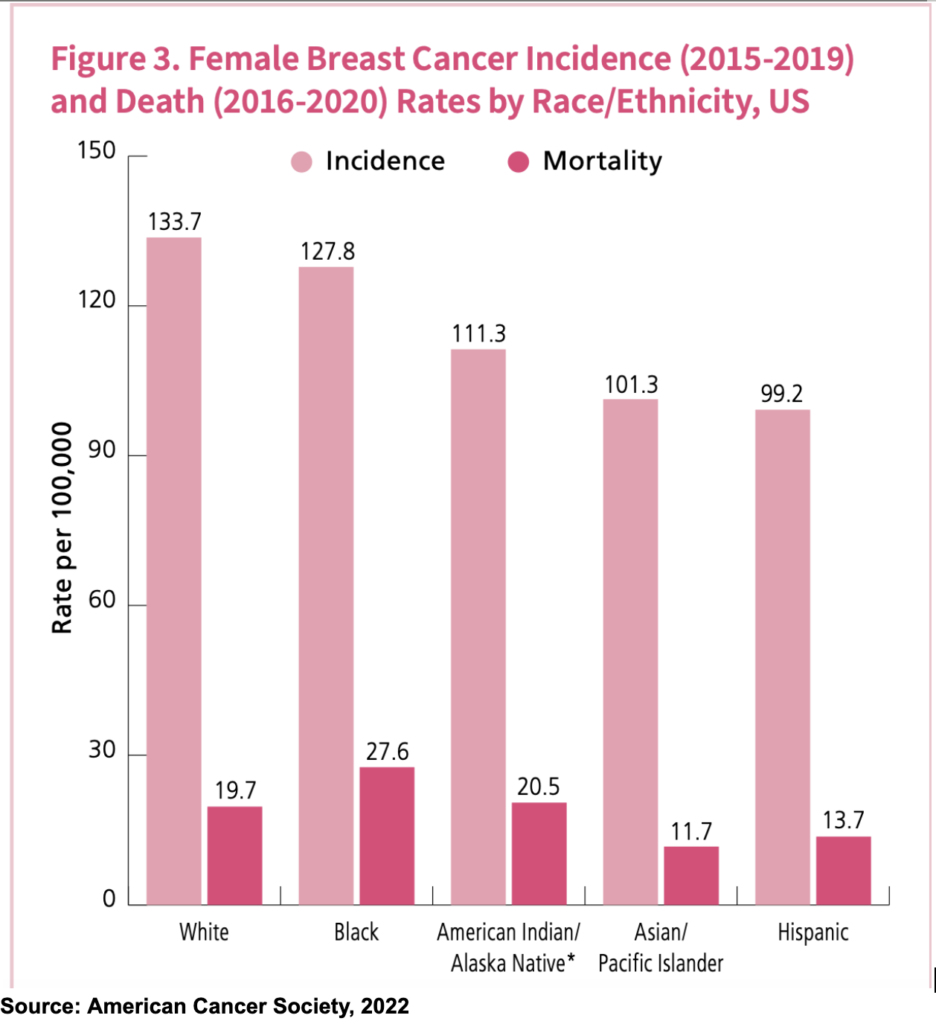Breast Cancer
early detection saves lives
Knowing your risk factors, adopting healthy habits and getting screened can help empower your health journey.
Breast Cancer
early detection saves lives
Knowing your risk factors, adopting healthy habits and getting screened can help empower your health journey.
What is Breast Cancer?
- Breast cancer occurs when a DNA mutation of the cells in the breast divides and grows out of control.
- Breast cancer can begin in different parts of the breast; most cases of breast cancer begins in the ducts or lobules.
- Tumors in the breast tend to grow slowly. By the time a lump is large enough to physically detect, it may have been growing for an extended period of time (some cases report as long as 10 years before being located). Some tumors are aggressive and grow much faster.
symptoms
- New lump in the breast or underarm (armpit).
- Thickening or swelling of part of the breast.
Irritation or dimpling of breast skin. - Redness or flaky skin in the nipple area or the breast.
- Pulling in of the nipple or pain in the nipple area.
- Nipple discharge other than breast milk, including blood.
- Any change in the size or the shape of the breast.
- Pain in any area of the breast.
Risk Factors
- Getting older
- Genetic mutations
- Having dense breasts.
- Personal history of breast cancer
- Family history of breast or ovarian cancer
Ways to Prevent
There are many factors that can influence your risk of developing breast cancer of the course of a lifetime, however, there are things that can be done to help lower the risk, such as:
- Maintaining a healthy weight.
- Staying active.
- Limiting alcohol consumption.
- Breastfeeding your children, if possible.
If you have a genetic predisposition or are taking any medications that may increase your risk, talk to your physician to determine to best course of action to help lower your risk.

Who is at RisK?
Women are most likely to be at risk for breast cancer. The older a woman is, the more likely she is to get breast cancer. Rates of breast cancer are low in women under 40. About 4% of women diagnosed with breast cancer in the U.S. are younger than 40 [6]. Rates begin to increase after age 40 and are highest in women over age 70.
Male Breast Cancer
- Breast cancer is most often found in women, but men can get breast cancer too. About 1 out of every 100 breast cancers diagnosed in the United States is found in a man.
- Male breast cancer is sometimes caused by inherited gene mutations (changes).
Male breast cancer is a disease in which malignant (cancer) cells form in the tissues of the breast.
Breast Cancer and Young Women
- About 4 percent of all breast cancers diagnosed in the U.S. occur in women under 40.
- Prognosis tends to be worse for women under 40 than for older women. This is because breast cancers in younger women can be more aggressive than breast cancers in older women.
- Age may play a role in the choice of certain treatment options. For example, younger women may be more likely than older women to get breast reconstruction after a mastectomy.
screening/detection
- Breast cancer screening means checking a woman’s breasts for cancer before there are signs or symptoms of the disease.
- Breast cancer screening cannot prevent breast cancer, it can help find breast cancer early.
- The goal of screening tests for breast cancer is to find it early before it causes symptoms (like a lump in the breast that can be felt).
Breast cancers found during screening exams are more likely to be smaller and less likely to have spread outside the breast.

Breast Self-Exam
Performing breast self-exams and regularly examining your breast yourself can lead to early detection of breast cancer.
Mammograms
A screening mammogram is a test that uses X-rays to create images of the breast.
- Mammograms are the most effective screening test used today to find breast cancer in most women.
- Screening mammograms can find breast cancer early, sometimes up to 10 years before it could be detected by you or your doctor.
- Have a mammogram every year starting at age 40 if you’re at average risk.
Diagnosis/Stages
If you’ve been diagnosed with breast cancer, you’ve probably heard a lot of different terms used to describe your cancer. Doctors use information from your breast biopsy to learn a lot of important things about the exact kind of cancer you have. You may also need more tests to get more details, such as the stage of the cancer or how fast it’s growing.
- Breast cancer is often first suspected when a lump or change is found in the breast or when an abnormal area is seen on a mammogram.
- Doctors use information from your breast biopsy to learn a lot of important things about the exact kind of breast cancer you have.
If you have been diagnosed with breast cancer, tests will be done to find out the extent (stage) of the cancer. The stage of a cancer helps determine how serious the cancer is and how best to treat it. - The stage of a cancer describes how much cancer is in the body.
- It helps determine how serious the cancer is and how best to treat it. Doctors also use a cancer’s stage when talking about survival statistics.
- The earliest stage breast cancers are stage 0 (carcinoma in situ). It then ranges from stage I (1) through IV (4). As a rule, the lower the number, the less the cancer has spread.
- A higher number, such as stage IV, means cancer has spread more. And within a stage, an earlier letter means a lower stage.
Although each person’s cancer experience is unique, cancers with similar stages tend to have a similar outlook and are often treated in much the same way.
- Metastatic breast cancer, also called stage 4, is the most advanced stage of breast cancer.
- Metastatic breast cancer is breast cancer that has spread beyond the breast and nearby lymph nodes to other parts of the body, most commonly the bones, lungs, liver, or brain.

STATISTICS FOR PEOPLE OF COLOR

- The racial disparity in deaths from breast cancer has remained at 40% or higher over the last decade.
- Black women younger than 50 had a death rate twice as high as White women the same age. Black women are also more likely than white women to die from breast cancer across the board.
- From 2016 through 2020, the breast cancer incidence rate was higher in Black women compared to White women in only 4 states: Alabama, Louisiana, Mississippi, and Virginia. In contrast, the breast cancer death rate was higher for Black women than White women in every state except Washington.

Learn more about the Stats at GRAAHI's Health Equity Index
Links, Tools, Resources
Websites
https://www.cancer.org/cancer/breast-cancer.html
https://www.cdc.gov/cancer/breast/
Breast Reconstruction
https://www.cancer.org/content/dam/CRC/PDF/Public/8582.00.pdf
Living as a Breast Cancer Survivor
https://www.cancer.org/content/dam/CRC/PDF/Public/8583.00.pdf
Triple Negative Breast Cancer
https://www.cdc.gov/cancer/breast/triple-negative.htm
Grand Rapids/Kent County/Michigan Resources
Michigan Breast Cancer Coalition https://www.mibcc.org/resources/patient-resources/
Gilda’s Club Grand Rapids – https://gildasclubgr.org
https://vitalstats.michigan.gov/osr/Cancer/Race/Kent_Num.asp
Latest Advances, Clinical Trials & Breakthroughs in Breast Cancer
https://www.cancer.gov/types/breast/research
https://www.pfizer.com/news/articles/4_breakthroughs_in_breast_cancer_treatment
Sources:
https://www.cdc.gov/cancer/breast/basic_info/what-is-breast-cancer.htm https://www.cancer.org/latest-news/facts-and-figures-african-american-black-people-2022-2024.html https://www.cancer.org/latest-news/facts-and-figures-african-american-black-people-2022-2024.html
https://www.everydayhealth.com/breast-cancer/breast-self-exam-how-to-do-one-and-what-to-look-for/